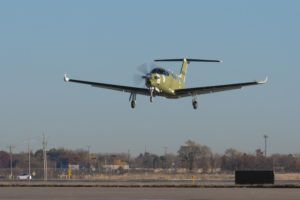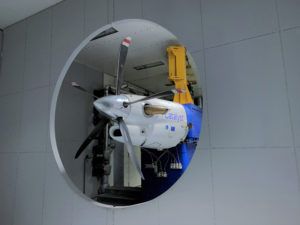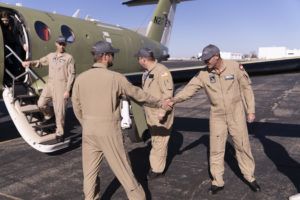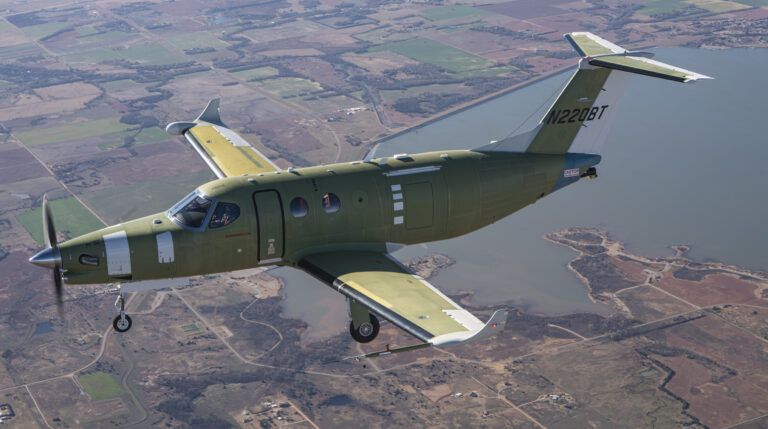Words by Paul Eden
Textron flew its Beechcraft Denali for the first time on November 23, 2021. The aircraft is a bold entrant into the single-turboprop market, which hasn’t seen an all-new design for more than 30 years. Even then in 199,1 the Pilatus’ PC-12 used the tried and trusted Pratt & Whitney PT6A engine, while Textron has chosen the potentially tougher route of combining a new engine with a new airframe.
The Denali’s competition comes from the PC-12, Piper M-class turboprops and Daher TBM series. It is a tough category of aircraft – where comfort must equal versatility and reliability. This is also a market populated by professional and owner / operator pilots, the latter perhaps stepping up from a high-performance piston single. The faster rate of progress in the turboprop, especially in critical flight phases must be carefully managed by aircraft systems. Textron then has the task of delivering an aircraft of outstanding performance with desirability, safety and reliability to match.
Originally listed under Textron’s Cessna brand, the Denali now sits more comfortably as a Beechcraft product, continuing a legacy of high-performance, single-engined executive / utility aircraft which began with the Model 17 Staggerwing of 1932. Ron Draper, Textron Aviation’s President and CEO, described the November 23, 2021 sortie as a “landmark flight”, while the flight test crew of senior test pilot Peter Gracey and chief test pilot Dustin Smisor were equally enthusiastic, Gracey reporting: “From the beginning of the flight to the end, the Denali was simply flawless. The Catalyst engine was outstanding, and the aircraft performed to the levels we were anticipating.”
Pre-flight planning

By the time Gracey and Smisor lifted the Denali off the runway at Wichita Dwight D. Eisenhower National Airport around 08:20 hours on the 23rd, they were already thoroughly familiar with it after many hours of ground trials.
Chris Hearne, senior vice president, engineering and programs, Textron Aviation, says, “The team started planning for the Denali’s first flight months in advance. The crew flew our iron bird simulator and other aircraft to ensure they were familiar with the flight profile. There were also numerous ground runs with the aircraft and practice rounds with the telemetry team.”
Maiden flights historically have been steps into the unknown, or at least the unpredictable. The Staggerwing, for example, proved challenging from the outset. But the purpose of modern first flights are to verify and confirm the accuracy of computer modeling and simulation. Hearne notes that the Denali’s initial trip revealed few surprises, a testament, he says, “to our extensive modeling / simulation and practice, the preparedness of the team and maturity of the product.”
Yet a first flight is still a significant milestone. David Kimball, Catalyst program leader at GE Aviation Turboprop, says, “Seeing the Denali take-off and land safely was a moment that I and the entire Catalyst team will remember for a lifetime. The Catalyst engine had accumulated over 3,000 hours of engine and component testing prior to the Denali first flight and by early February 2022 the flight test campaigns totaled 150 hours of engine flight time.”
Almost 40 planned tests were completed during the 2 hour 50 minute flight, assessing performance, stability and control, and propulsion, environmental, flight controls and avionics systems. “These tests included airspeed envelope expansion to 180kt [207mph] while staying below 16,000ft,” Hearne says. “All tests were successfully completed and recorded by the extensive onboard instrumentation system as well as being observed by the chase aircraft and large telemetry support team.”
Telemetry will remain in extensive use as flight trials continue towards planned certification in 2023. Hearne adds: “The program will also use post-flight data from onboard instrumentation and video. A typical flight test crew consists of two pilots but, depending on the nature of the test, the crew will sometimes include an onboard flight test engineer or have support from a team in telemetry.”
Catalyst advances

The GE Aviation Catalyst engine has been developed from the Advanced Turboprop (ATP) concept for Textron’s Single Engine Turboprop (SETP), today’s Denali. Late in 2019, Textron revealed that new test requirements for the Catalyst engine would delay the Denali’s first flight to an unscheduled future date. The flight had already been postponed from a planned third-quarter 2018 schedule.
However, it seems that the engine has been worth the wait. Additive manufacturing has been used to create a lighter, more efficient turboprop, reducing an 855-part count to 12. It also has digital controls. Kimball says, “It has FADEC [full-authority digital engine control] which collects data throughout the entire engine to optimize power generation and fuel consumption.
“We can track, trend, and communicate numerous outputs – including pressures, temperatures, speeds and more – to predict maintenance and provide feedback to customers.
“The engine and FADEC have been designed for pilot simplification and safety during all stages of operation. All these systems are trialed and tested during the engine ground and flight test campaigns, and on comprehensive component test systems representing the entire propeller and engine control loops.”
Ground testing for Catalyst certification is happening at the same time as engine / aircraft flight testing is being conducted in Wichita, USA and on a flying test bed [FTB] in Berlin.
Joshua Hobson, customer program manager at GE Aviation Turboprop says, “We have completed more than 3,000 hours of engine and component testing across 17 test vehicles, five dedicated test cells and using altitude / ingestion testing facilities.
“Under all conditions, the engine has exceeded performance expectations throughout the operating envelope and in harsh environments. GE is certifying the Catalyst to the latest 14 CFR Part 33 regulations, including ICI [ice crystal icing] testing.”
GE Aviation’s Catalyst trials commitment includes a team on site in Wichita, working closely with Textron Aviation to support the Denali flight test campaign. Hobson says, “The team supports daily pre- and post-flight briefings, real-time flight test monitoring and engine maintenance activities while leveraging the global GE team to conduct detailed analysis of engine performance on-wing.”
Ease of maintenance is built into the Catalyst engine and that maintainability, as well as reliability, are further key test parameters. Kimball continues, “Catalyst is designed to offer on condition maintenance and module replacement in the field, while GE is also partnering with Textron to comply with the Maintenance Steering Committee 3 industry standards and jointly develop accurate simulator and robust maintenance training programs for global operators and service readiness at entry
into service.”
Alongside every other demand made upon the Denali by owners and operators, sustainability assumes significant importance. The use of sustainable aviation fuel (SAF) provides the opportunity to reduce carbon emissions by as much as 80% compared to burning regular Jet A. SAF availability is continuing to expand while current regulations permit a blend of up to 50%. Eventual compliance for 100% blends is inevitable and GE expects to certify the Catalyst engine for use with 100% SAF during the next one to two years.
Flying the Denali

Textron Aviation has equipped the Denali with Garmin G3000 avionics, while optimized engine / propeller integration will ease pilot powerplant management workload and enhance safety. Dan Lind, senior director of aviation sales and marketing at Garmin says, “We work with our aircraft manufacturing partners early on in the development process to integrate a number of aircraft and third-party avionics systems. Testing takes place on ground test benches and in aircraft but varies between manufacturers.”
On the Denali, an integrated Garmin autothrottle is standard, interfacing with the automatic flight control system and flight management system to provide what Textron describes as “easy speed control throughout all regimes of flight from take-off to touchdown”.
Single-lever, jet-like engine control is exercised through the combination of the GE engine and all-new 105in (2.67m) diameter, five-blade, fully feathering constant speed McCauley composite propeller, which is capable of reverse pitch and includes ice protection.
Hobson says, “GE and McCauley jointly developed a patented propeller control system that optimizes blade angle to maximize power extraction and thrust. The companies have integrated and tested McCauley’s new propeller through extensive testing, spanning multiple ground testing facilities as well as flight testing on the FTB in Berlin and the Denali in Wichita.”
After the Denali’s first flight, Textron’s Ron Draper said, “With its more environmentally friendly engine and largest cabin in its class, this is an aircraft that will change the landscape for high-performance single-engine turboprop aircraft.”
Now, Textron Aviation and its partners, GE Aviation prominent among them, have an exacting test and certification campaign to complete before that prophecy has a chance to come true.





